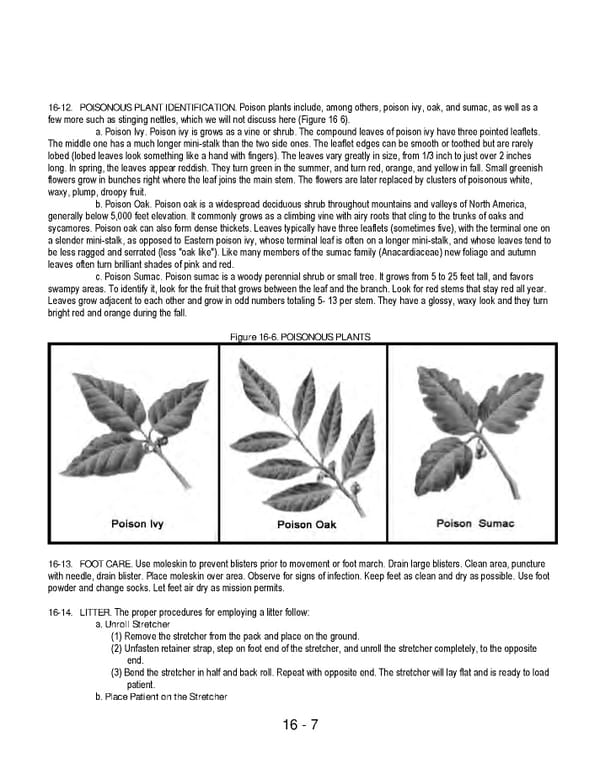16 - 7 16-12. POISONOUS PLANT IDENTIFICATION. Poison plants include, among others, poison ivy, oak, and sumac, as well as a few more such as stinging nettles, which we will not discuss here (Figure 16 6). a. Poison Ivy. Poison ivy is grows as a vine or shrub. The compound leaves of poison ivy have three pointed leaflets. The middle one has a much longer mini-stalk than the two side ones. The leaflet edges can be smooth or toothed but are rarely lobed (lobed leaves look something like a hand with fingers). The leaves vary greatly in size, from 1/3 inch to just over 2 inches long. In spring, the leaves appear reddish. They turn green in the summer, and turn red, orange, and yellow in fall. Small greenish flowers grow in bunches right where the leaf joins the main stem. The flowers are later replaced by clusters of poisonous white, waxy, plump, droopy fruit. b. Poison Oak. Poison oak is a widespread deciduous shrub throughout mountains and valleys of North America, generally below 5,000 feet elevation. It commonly grows as a climbing vine with airy roots that cling to the trunks of oaks and sycamores. Poison oak can also form dense thickets. Leaves typically have three leaflets (sometimes five), with the terminal one on a slender mini-stalk, as opposed to Eastern poison ivy, whose terminal leaf is often on a longer mini-stalk, and whose leaves tend to be less ragged and serrated (less "oak like"). Like many members of the sumac family (Anacardiaceae) new foliage and autumn leaves often turn brilliant shades of pink and red. c. Poison Sumac. Poison sumac is a woody perennial shrub or small tree. It grows from 5 to 25 feet tall, and favors swampy areas. To identify it, look for the fruit that grows between the leaf and the branch. Look for red stems that stay red all year. Leaves grow adjacent to each other and grow in odd numbers totaling 5- 13 per stem. They have a glossy, waxy look and they turn bright red and orange during the fall. Figure 16-6. POISONOUS PLANTS 16-13. FOOT CARE. Use moleskin to prevent blisters prior to movement or foot march. Drain large blisters. Clean area, puncture with needle, drain blister. Place moleskin over area. Observe for signs of infection. Keep feet as clean and dry as possible. Use foot powder and change socks. Let feet air dry as mission permits. 16-14. LITTER. The proper procedures for employing a litter follow: a. Unroll Stretcher (1) Remove the stretcher from the pack and place on the ground. (2) Unfasten retainer strap, step on foot end of the stretcher, and unroll the stretcher completely, to the opposite end. (3) Bend the stretcher in half and back roll. Repeat with opposite end. The stretcher will lay flat and is ready to load patient. b. Place Patient on the Stretcher
 Ranger Handbook Page 302 Page 304
Ranger Handbook Page 302 Page 304